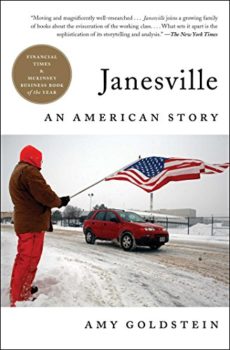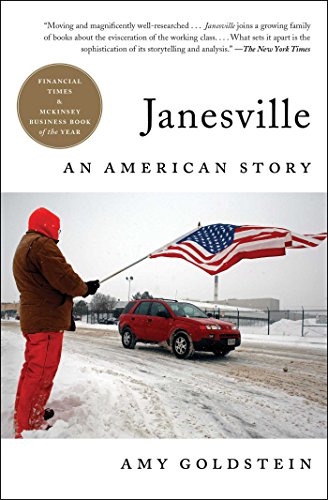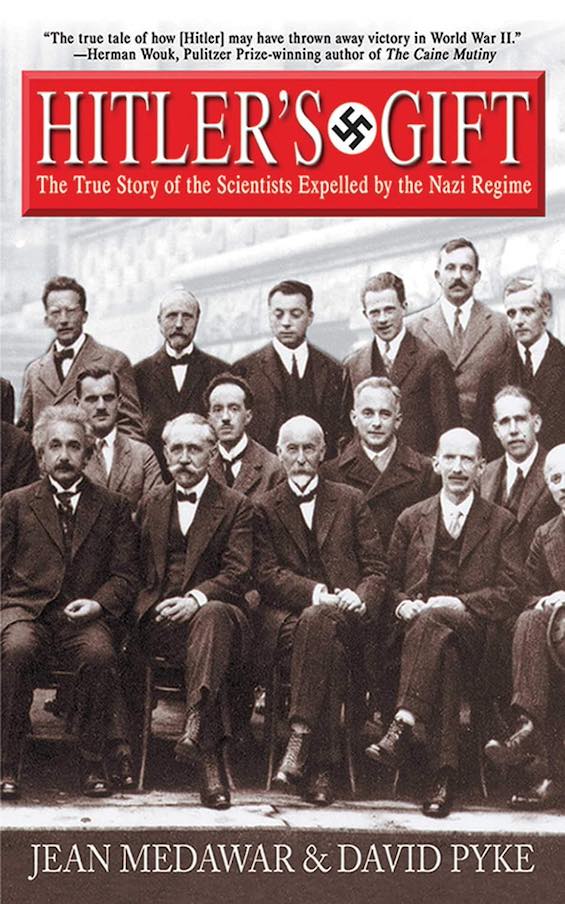
Amy Goldstein frames her insightful new book, Janesville, as An American Story. By following the fortunes of a half-dozen families in Janesville, Wisconsin, Goldstein dramatizes the impact of the Great Recession of 2008 in the years following the closure of a large Chevrolet factory. The recession officially ended in June 2009, but Goldstein eloquently shows that the pain it inflicted on the people of Janesville has lasted to this day. This is, indeed, an American story. Particulars aside, what took place in Janesville beginning in 2008 happened throughout the United States.
A microscopic look at the human cost of the Great Recession
Goldstein’s approach is microscopic. She uses statistics sparingly and rarely places the town’s experience in the larger, national context. “The work that vanished—as many as nine thousand people lost their jobs in and near this county seat in 2008 and 2009—was among 8.8 million jobs washed away in the United States by what came to be known as the Great Recession.” But Goldstein doesn’t write as an economist or a pundit. She writes with empathy and understanding about the plight of individual human beings. The result is an intimate look at the painful choices the recession (and globalization) have forced on so many of the families of a once-prosperous town.
Janesville: An American Story by Amy Goldstein (2017) 369 pages ★★★★★
By now, the recession has passed. The unemployment rate in Janesville, once well over 10%, stands at the current national average of 4.1%. But for many of the 3,000 workers who lost their jobs when General Motors shuttered its Janesville plant on December 23, 2008, life has never been the same since. And for some it will never again offer the comfortable existence that GM’s $28-an-hour wages afforded them. The evidence of this decline lies in the sharp rise in home foreclosures, the sudden emergence of homeless kids, the huge decline in receipts for the United Way, and the doubling of the suicide rate in Janesville’s Rock County.
Lessons to be learned from Janesville
I take three lessons from my reading of Goldstein’s book.
- The author notes that “The evidence is thin that job training in the United States is an effective way to lead laid-off workers back into solid employment.” In fact, the specific accounts she relates in Janesville suggest the opposite. There, even the most ambitious and carefully planned job-training efforts failed to lead even half of its graduates to paying work. To say this is discouraging is a sad understatement. Consider the human cost of this error in policy planning. What is the alternative other than the approach favored in Scandinavia? There, extremely generous unemployment benefits help families sustain a comfortable lifestyle until improved economic conditions create enough new jobs.
- Following the GM layoff two days before Christmas, 2008, thousands of Janesville families lost more than a comfortable income. As the months without new jobs stretched into years, the unemployed workers and their families often found themselves depending on handouts of food. And the psychological problems weighed even more heavily in many families: shame, depression, conflicts over money, even suicide. Even when both the wife and husband found work again, they never earned even close to the living wages their union jobs had paid them. To my mind, the lesson here is simple. The people of Janesville and of our country as a whole are paying an enormous price for the decades-long decline of the trade union movement.
- Goldstein writes about how “the city was splitting into its two Janesvilles, separated by political outlook and economic circumstance.” She cites anecdotes and observations by local officials about the bitterness and polarization that became so evident in the years following the end of the recession. I take this as evidence of the poisonous effect of economic inequality. That trend, projected onto the national stage, surely helps explain how an ill-prepared, narcissistic demagogue could have been elected President of the United States in 2016.
My own experience in the Rust Belt
I grew up in Lima, Ohio in the 1950s before rust began to take hold in the heartland. Lima was then a prosperous industrial town. The community boasted a Sohio oil refinery, an Ohio Steel plant, a Ford Motor factory, a Westinghouse small motor plant, a plastics manufacturer, the Baldwin-Lima-Hamilton locomotive works, and a Superior Coach factory—and those are just the ones I remember after more than half a century. About 50,000 people lived in town then. The current population is around 37,000. Of all the manufacturers that once operated in Lima, what remain today are only the Ford Motor plant and the refinery, now owned by a Canadian company. The town’s biggest employer by far is St. Rita’s Hospital with 3,000 employees.
On my last visit to Lima a decade ago, I found a town that barely resembled the place where I lived until I turned 18. I have no personal knowledge of the struggles faced by so many people in town as the factories shut down, one after another, but I’m certain their experiences were similar in many ways to those of the people of Janesville.
Amy Goldstein, a staff writer for 30 years at The Washington Post, shared the 2002 Pulitzer Prize for national reporting. Janesville: An American Story is her first book.
For related reading
This is one of the books included in my post 10 enlightening books about poverty in America.
Like to read books about business? Check out My 10 favorite books about business history.
If you enjoy reading nonfiction in general, you might also enjoy:
- Science explained in 10 excellent popular books
- Great biographies I’ve reviewed: my 10 favorites
- Top 10 nonfiction books about politics
And you can always find my most popular reviews, and the most recent ones, on the Home Page.


























